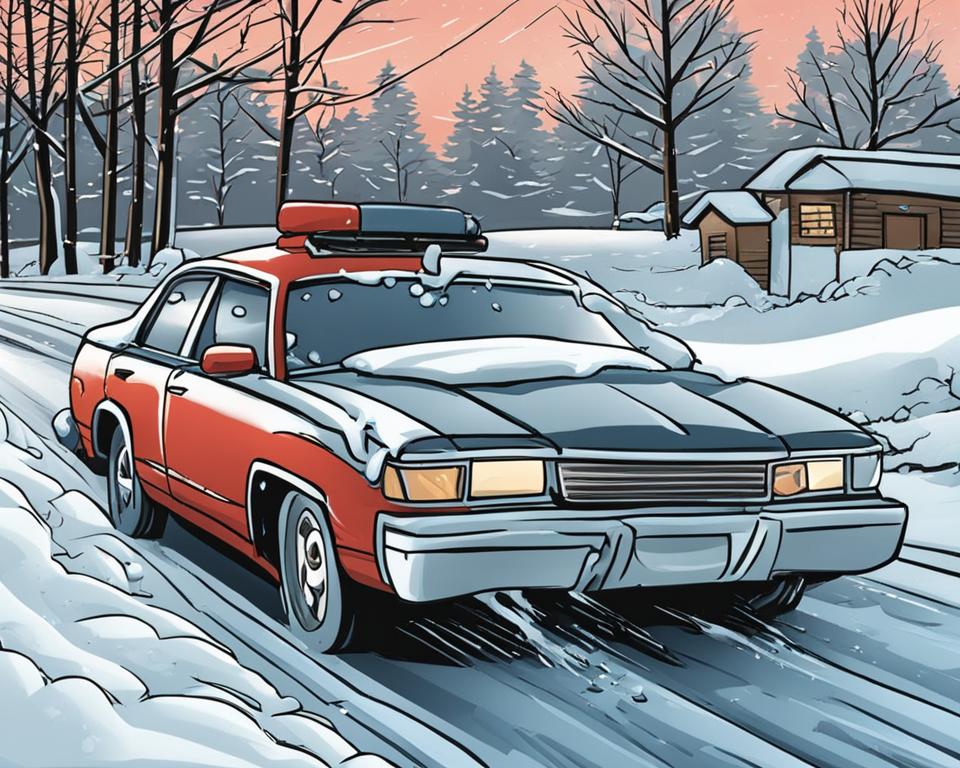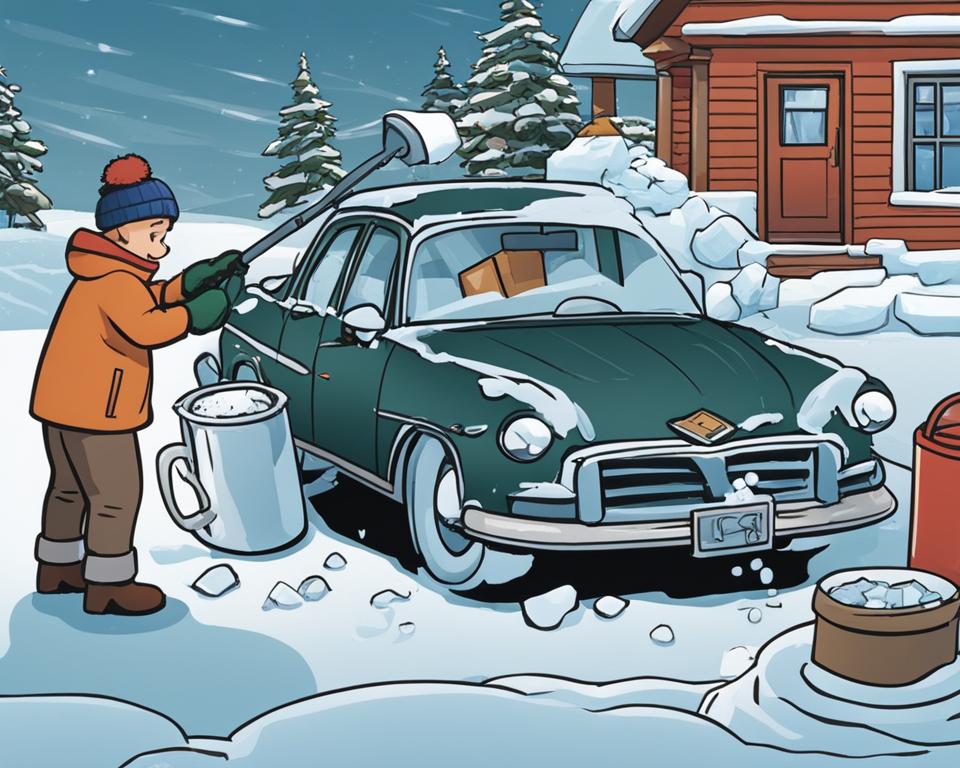Preventing your windshield from freezing is essential for safe winter driving. When your windshield is covered in ice, it not only hinders your visibility but also adds extra time and effort in removing the ice before you can start your journey. By taking a few simple precautions, you can save yourself from the hassle of scraping ice off your windshield every morning and ensure clear visibility on the road.
During the winter months, it’s important to give your windshield some extra care to prevent ice formation. By following these tips, you can keep your windshield frost-free and maintain optimal visibility:
Key Takeaways:
- Utilize homemade de-icer solutions or store-bought options like vinegar, alcohol, or salt solutions to prevent ice formation.
- Apply these solutions every night and store them at room temperature for effective prevention.
- Park your car facing east to minimize exposure to the cold wind.
- Cover your side mirrors with plastic bags to prevent ice buildup.
- Wipe down windshield wiper blades with rubbing alcohol to keep them from freezing.
By implementing these preventive measures, you can ensure a frost-free windshield and maintain clear visibility during the winter months. Remember, safe driving starts with a clear view, so take the necessary steps to prevent ice from obstructing your vision.
How to Defrost Car Windows in the Morning
If you prefer to clear the ice off your windshield in the morning, you can use homemade de-icer solutions such as vinegar or salt and alcohol mixtures. Apply the solution to the windshield and remove it with a squeegee, soft-bristled brush, or windshield wipers. It is important to note that allowing your car to warm up by idling is not recommended, as it is not environmentally friendly and can lead to costly damage in the long run. By utilizing these morning de-icing methods, you can quickly and efficiently remove ice from your windshield.
Tips for Defrosting Car Windows:
- Prepare a homemade de-icer solution using vinegar or a salt and alcohol mixture.
- Apply the solution to your windshield, ensuring full coverage.
- Use a squeegee, soft-bristled brush, or windshield wipers to remove the ice.
- Avoid idling your car to warm it up, as it is not environmentally friendly and can lead to damage.
Defrosting your car windows in the morning doesn’t have to be a time-consuming task. By following these simple steps and using homemade de-icer solutions, you can quickly clear the ice from your windshield and get on with your day. Remember to be gentle when removing the ice to avoid scratching the glass, and always prioritize safety when driving in winter conditions.
| Homemade De-Icer Solutions | Ingredients | Instructions |
|---|---|---|
| Vinegar Solution | – 3 parts vinegar – 1 part water |
1. Mix vinegar and water in a spray bottle. 2. Spray the solution onto your windshield. 3. Use a squeegee or soft-bristled brush to remove the ice. |
| Salt and Alcohol Mixture | – 1 tablespoon salt – 1 cup rubbing alcohol |
1. Dissolve salt in rubbing alcohol. 2. Apply the mixture to your windshield. 3. Remove the ice using a squeegee or soft-bristled brush. |
How to Prevent Ice on Other Car Areas
In addition to preventing ice on your windshield, it is crucial to address other areas of your car that may freeze, such as car locks and doors. Taking these measures will ensure easy access to your vehicle in freezing conditions. Here are some tips to prevent ice on these car areas:
Frozen Car Locks
Dealing with frozen car locks can be frustrating, but there are a few simple solutions to try:
- Use a straw to blow warm breath onto the lock. The heat from your breath can help melt the ice.
- Spray hand sanitizer or rubbing alcohol onto the lock. These liquids have a low freezing point and can quickly melt the ice.
- Warm up your car key by holding it in your hand or using a hairdryer before inserting it into the lock.
Frozen Car Doors
When your car doors freeze shut, here’s what you can do:
- Apply silicone spray to the door sealing strips. This will help prevent ice from forming and make it easier to open the doors.
- If the doors are already frozen shut, use a de-icer solution to break up the ice. Gently push on the door to open it without force.
Image
![]()
Using these tips and techniques, you can keep your car locks and doors ice-free during the winter months. Remember to always be careful when dealing with frozen car parts to avoid any damage.
How to Deal with Ice on the Inside of Your Windshield
If you find ice forming on the inside of your windshield, it can be a frustrating and inconvenient problem. This issue is typically caused by moisture entering your car and condensing on the cold surface of the glass. To prevent ice from forming on the inside of your windshield, it’s important to address the sources of moisture and maintain proper airtightness in your vehicle.
To start, check for any window or seal leaks that may be allowing moisture to enter your car. Inspect the rubber seals around your windows and doors for any cracks or gaps. If you notice any issues, it’s recommended to have them fixed by a professional to ensure a proper seal. A window leak can not only cause ice formation but can also lead to water damage inside your car.
Additionally, using moisture-absorbing materials inside your car can help reduce the humidity levels and prevent frost from forming. Consider placing cat litter or silica gel packs in your car to absorb excess moisture. These materials are designed to absorb water and can help maintain a drier environment inside your vehicle.
Window Leak Check:
| Step | Action |
|---|---|
| 1 | Inspect rubber seals around windows and doors for cracks or gaps. |
| 2 | If any issues are found, have them fixed by a professional to ensure a proper seal. |
By taking these measures to prevent moisture from entering your car and maintaining proper airtightness, you can minimize the formation of ice on the inside of your windshield. Remember to regularly check for any potential leaks and address them promptly to avoid future issues.

Conclusion
Preventing ice on your windshield is crucial for maintaining clear visibility and ensuring safe winter driving. By following the tips outlined in this guide, including utilizing homemade de-icer solutions, covering your windshield, parking strategically, and addressing other areas prone to freezing, you can effectively protect your windshield from ice formation. Remember to always prioritize safety on the road and take the necessary precautions to prevent ice from obstructing your vision.
To maintain clear visibility, it’s important to regularly apply homemade de-icer solutions or store-bought options such as vinegar, alcohol, or salt solutions. These solutions, when applied every night and stored at room temperature, will help keep your windshield frost-free. Additionally, parking your car facing east, covering the side mirrors with plastic bags, and wiping down windshield wiper blades with rubbing alcohol are simple yet effective ways to prevent ice from forming on your windshield.
Winter driving safety should never be compromised. Take the time to address other areas of your car that may freeze, such as car locks and doors. Using methods like blowing warm breath onto frozen locks, spraying hand sanitizer or rubbing alcohol, and applying silicone spray to door sealing strips will ensure easy access to your vehicle in freezing conditions. Furthermore, preventing ice on the inside of your windshield is possible by checking for window or seal leaks and using moisture-absorbing materials like cat litter or silica gel packs.
Remember, maintaining clear visibility is essential for safe driving in winter. By following these preventive measures and maintaining your car’s interior, you can confidently navigate through winter weather conditions without the worry of an icy windshield obstructing your view.
FAQ
How can I prevent my windshield from freezing?
You can prevent your windshield from freezing by utilizing homemade de-icer solutions or store-bought options such as vinegar, alcohol, or salt solutions. Applying these solutions every night and storing them at room temperature will effectively keep your windshield frost-free. Additionally, parking your car facing east, covering the side mirrors with plastic bags, and wiping down windshield wiper blades with rubbing alcohol will further protect your windshield from freezing.
How do I defrost car windows in the morning?
To defrost car windows in the morning, you can use homemade de-icer solutions such as vinegar or salt and alcohol mixtures. Apply the solution to the windshield and remove it with a squeegee, soft-bristled brush, or windshield wipers. It is important to note that allowing your car to warm up by idling is not recommended, as it is not environmentally friendly and can lead to costly damage in the long run.
How can I prevent ice on other car areas?
To prevent ice on car locks, you can use a straw to blow warm breath onto the lock, spray hand sanitizer or rubbing alcohol, or warm up the car key before inserting it into the lock. To prevent frozen car doors, you can apply silicone spray to the door sealing strips or use a de-icer solution to break up the ice and gently open the door.
What should I do if there is ice on the inside of my windshield?
Ice forming on the inside of your windshield can be caused by moisture entering your car. Ensure all possible openings in your car are properly closed and free of leaks. If you notice frost developing inside your car frequently, it may indicate a window or seal leak that should be inspected by a professional. Using moisture-absorbing materials such as cat litter or silica gel packs inside your car can help reduce moisture and prevent frost formation.


